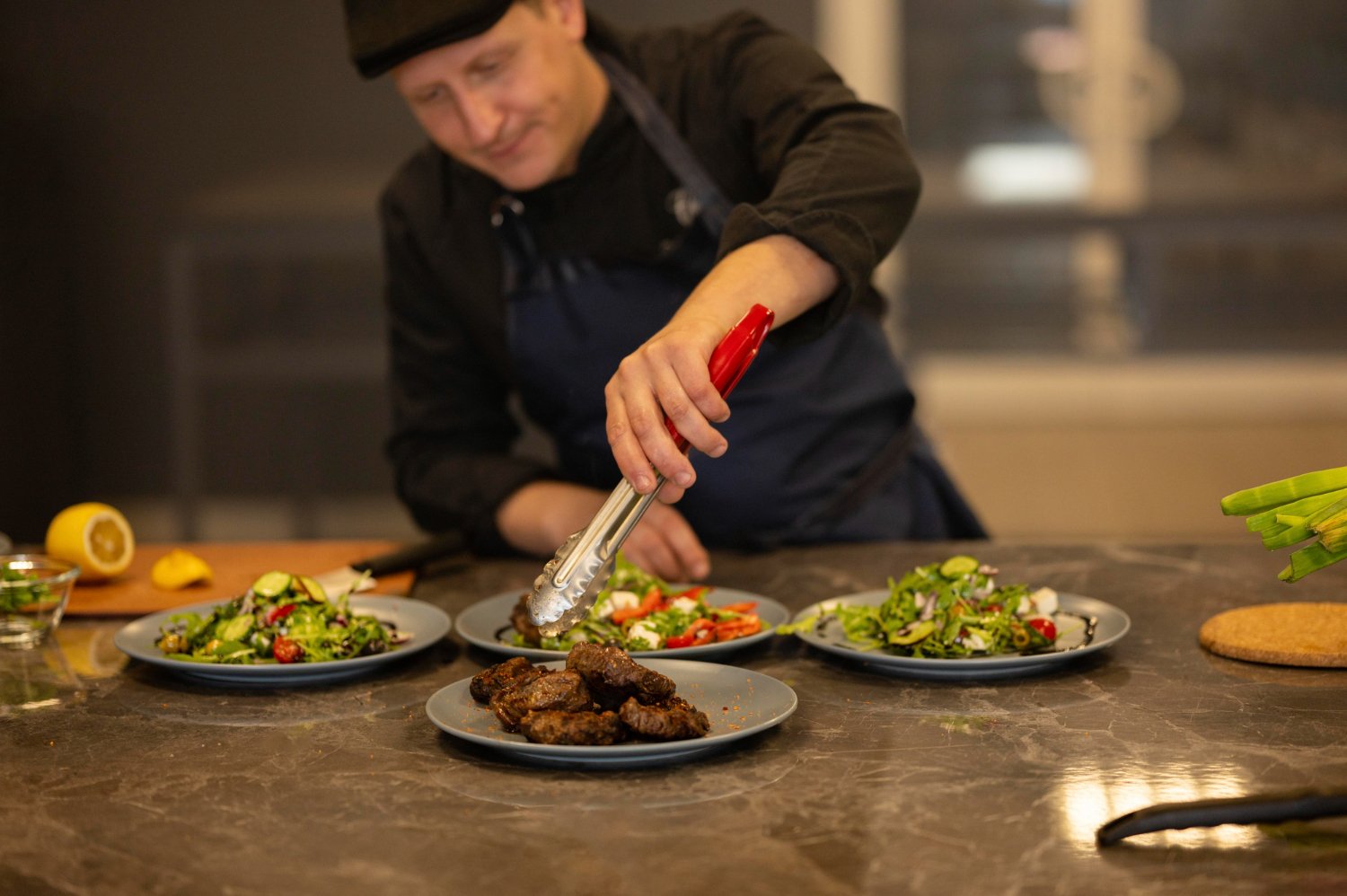Introduction
Restaurant Where You Cook Your Own Food: Dining out can be an incredible experience, but for some, the thrill of cooking your own meal adds a unique touch. Restaurants where you cook your own food offer an interactive dining experience that blends the fun of cooking with the enjoyment of eating out. Whether you’re looking for a fun date night, a family gathering, or a new culinary adventure, these restaurants provide an engaging way to enjoy a meal. In this comprehensive guide, we will explore the concept of these restaurants, their benefits, popular types, and tips for making the most out of your dining experience.
What Are Restaurants Where You Cook Your Own Food?
Restaurant Where You Cook Your Own Food: Restaurants where you cook your own food, often referred to as “cook-your-own” or “DIY” dining establishments, offer diners the chance to prepare their own meals at the table. These restaurants typically provide the raw ingredients and necessary tools, leaving the cooking to you. The concept can vary widely, from BBQ grills embedded in the tables to hot pots and fondue stations.
The Concept
The core idea behind these restaurants is to enhance the dining experience by allowing patrons to participate in the cooking process. This interactive element transforms a meal into a social and engaging activity. It also gives diners more control over how their food is cooked, ensuring it meets their personal taste preferences.
Why Choose a DIY Dining Experience?
Interactive Fun: Cooking your own food can be a fun and engaging activity, particularly in a group setting.
Customization: You have complete control over how your food is cooked and seasoned.
Culinary Exploration: It’s an opportunity to experiment with different cooking techniques and ingredients.
Social Experience: It encourages conversation and interaction among diners.
Popular Types of Restaurants Where You Cook Your Own Food
Restaurant Where You Cook Your Own Food: Several popular types of DIY dining establishments cater to different culinary tastes and preferences. Here are some of the most common types:
Korean BBQ
Korean BBQ restaurants are a popular example where diners grill their own meats and vegetables at the table. Each table is equipped with a built-in grill, and guests can order a variety of marinated meats, seafood, and vegetables. The experience is complemented by a range of side dishes, known as banchan, which include pickled vegetables, kimchi, and more.
Key Features:
Built-in grill or hot plate at each table.
Variety of meats, seafood, and vegetables.
Accompanied by side dishes and dipping sauces.
Hot Pot
Hot Pot restaurants offer a communal cooking experience where diners cook raw ingredients in a simmering pot of broth. Guests choose from an assortment of meats, seafood, vegetables, and noodles, which are then cooked in a flavorful broth at the table. This type of dining is popular in Asian cuisines, particularly Chinese and Thai.
Key Features:
Large pot of broth or stock at the table.
Selection of raw ingredients to cook.
Various dipping sauces and condiments.
Fondue
Fondue restaurants focus on dipping ingredients into a pot of melted cheese, chocolate, or broth. The restaurant provides a fondue pot and skewers, while diners select from a variety of dippable items such as bread, vegetables, fruit, and meats. This interactive dining experience is both fun and indulgent.
Key Features:
Fondue pot with cheese, chocolate, or broth.
Skewers for dipping ingredients.
Variety of dippable items.
Shabu-Shabu
Shabu-Shabu is a Japanese hot pot dish where diners cook thinly sliced meat and vegetables in a pot of boiling broth. The name “shabu-shabu” comes from the sound of the ingredients being swished in the pot. It’s a social dining experience that emphasizes fresh ingredients and quick cooking.
Key Features:
Pot of boiling broth for cooking.
Thinly sliced meats and fresh vegetables.
Fast cooking and dipping sauces.
Teppanyaki
Teppanyaki restaurants offer a style of Japanese cuisine where diners cook their food on a hot griddle or iron plate. While some teppanyaki restaurants have chefs who cook in front of the guests, others provide the griddle for diners to use. The experience is often accompanied by a lively cooking show, where chefs perform tricks and cook meals with flair.
Key Features:
Hot griddle or iron plate for cooking.
Variety of meats, seafood, and vegetables.
Potential for live cooking demonstrations.
Benefits of Dining at a Restaurant Where You Cook Your Own Food
Restaurant Where You Cook Your Own Food: Choosing a restaurant where you cook your own food comes with several benefits that can enhance your dining experience. Here are some of the top advantages:
Enhanced Flavor Control
When you cook your own food, you have complete control over how it is prepared. You can adjust the seasoning, cooking time, and level of doneness to suit your personal taste. This level of customization ensures that every bite meets your expectations.
Social Interaction
Cooking together can be a great way to bond with friends and family. The interactive nature of these restaurants encourages conversation and teamwork, making it an ideal choice for group outings and celebrations.
Culinary Learning Experience
For those interested in learning more about cooking techniques and ingredients, these restaurants offer a hands-on experience. You can experiment with different methods and gain a deeper understanding of the cooking process.
Fun and Entertainment
The DIY aspect of cooking your own meal adds an element of fun and entertainment to the dining experience. It’s not just about eating; it’s about enjoying the process of preparing the food.
Healthy Eating
When you control the cooking process, you can make healthier choices by using fresh ingredients and avoiding excessive amounts of oil or salt. This can lead to a more nutritious meal.
Tips for Making the Most of Your DIY Dining Experience
Restaurant Where You Cook Your Own Food: To ensure you have a memorable and enjoyable experience at a restaurant where you cook your own food, keep the following tips in mind:
Understand the Menu
Before you arrive, familiarize yourself with the menu and the cooking methods used at the restaurant. Knowing what to expect can help you make informed choices and prepare for the dining experience.
Communicate Preferences
Don’t hesitate to communicate your preferences to the restaurant staff. Whether you like your meat well-done or prefer a particular type of broth, letting the staff know can enhance your dining experience.
Practice Food Safety
When cooking your own food, practice proper food safety to avoid cross-contamination and ensure that everything is cooked to a safe temperature. Use separate utensils for raw and cooked ingredients and follow the restaurant’s guidelines for cooking times.
Enjoy the Experience
Remember, the focus of dining at these restaurants is the experience. Embrace the opportunity to cook and have fun with your companions. The meal is just one part of the enjoyment.
Try New Things
Be open to trying new ingredients and cooking techniques. The variety of options available can offer a great opportunity to expand your culinary horizons and discover new favorites.
Popular Restaurants Where You Can Cook Your Own Food
Restaurant Where You Cook Your Own Food: If you’re interested in trying a restaurant where you cook your own food, here are a few popular establishments to consider:
Koreatown BBQ (Various Locations)
Koreatown BBQ restaurants are known for their interactive Korean BBQ experience. With a range of marinated meats and traditional side dishes, these restaurants offer a fun and flavorful dining experience.
Hot Pot City (Various Locations)
Hot Pot City provides a wide selection of broths and ingredients for a personalized hot pot experience. Guests can enjoy cooking and dipping their choices into the simmering pot.
The Melting Pot (Various Locations)
The Melting Pot specializes in fondue dining, offering cheese, chocolate, and broth options for dipping. The interactive experience makes it a popular choice for special occasions and celebrations.
Shabu Shabu House (Various Locations)
Shabu Shabu House offers a traditional Japanese hot pot experience, where diners cook thinly sliced meats and vegetables in a pot of boiling broth.
Benihana (Various Locations)
Benihana is a well-known teppanyaki restaurant where diners can enjoy a meal cooked on a hot griddle by skilled chefs, combining entertainment with delicious food.
Conclusion: Restaurant Where You Cook Your Own Food:
Restaurant Where You Cook Your Own Food: Restaurants where you cook your own food offer a unique and interactive dining experience that goes beyond traditional eating out. With various types such as Korean BBQ, hot pot, fondue, shabu-shabu, and teppanyaki, there’s something for everyone to enjoy. These establishments not only provide a fun and engaging way to dine but also allow you to customize your meal to your exact preferences. Whether you’re looking for a new culinary adventure or a memorable night out with friends and family, cooking your own food at the table adds a special touch to your dining experience. So, next time you’re searching for a dining option, consider giving a DIY restaurant a try – you might discover a new favorite way to enjoy a meal!
Frequently Asked Questions
Q:1 What types of restaurants offer a DIY cooking experience?
A:1 Restaurants offering a DIY cooking experience include Korean BBQ, hot pot, fondue, shabu-shabu, and teppanyaki. Each type provides a different interactive cooking style, allowing diners to prepare their own meals at the table.
Q:2 Do I need any special skills to cook my own food at these restaurants?
A:2 No special skills are required. Most restaurants provide easy-to-use equipment and instructions on how to cook your food. Staff are usually available to assist if you have any questions or need help.
Q:3 Are there any safety concerns with cooking at the table?
A:3 Yes, it’s important to follow food safety practices, such as using separate utensils for raw and cooked ingredients to prevent cross-contamination. Be sure to cook meats and seafood to the recommended temperatures to ensure they are safe to eat.
Q:4 Can I choose my own ingredients at these restaurants?
A:4 Most DIY dining restaurants allow you to select from a menu of ingredients, so you can choose what you want to cook. Some restaurants provide a fixed menu with a variety of options, while others may offer an a la carte selection.
Q:5 Is it expensive to dine at a restaurant where you cook your own food?
A:5 Prices can vary widely depending on the type of restaurant and the ingredients you choose. Korean BBQ, hot pot, and fondue restaurants often offer different pricing structures, such as all-you-can-eat options or pay-per-item. It’s a good idea to check the restaurant’s menu and pricing in advance.
Q:6 How long does it take to cook food at these restaurants?
A:6 The cooking time depends on the type of food and cooking method. For example, grilling meats at a Korean BBQ may take a few minutes per piece, while simmering ingredients in a hot pot might take slightly longer. The interactive nature of these restaurants means you can control the cooking time based on your preferences.
Q:7 Are these restaurants suitable for large groups?
A:7 Yes, many DIY cooking restaurants are well-suited for large groups and family gatherings. They often have communal tables or private rooms where groups can enjoy the interactive dining experience together. It’s advisable to make a reservation in advance for larger parties.
Q:8 Can I visit a DIY restaurant if I have dietary restrictions?
A:8 Most DIY restaurants offer a variety of ingredients to accommodate different dietary restrictions. It’s best to inform the restaurant staff about any allergies or dietary needs when you make a reservation or upon arrival. They can help guide you to suitable options on the menu.
Q:9 Do I need to bring anything with me?
A:9 Generally, you don’t need to bring anything extra as these restaurants provide all the necessary tools and ingredients for cooking. However, it’s a good idea to bring a small bag for any personal items or leftover food.
Q:10 Are reservations required at these restaurants?
A:10 Reservations are often recommended, especially during peak dining times or for larger groups. Some restaurants may accept walk-ins, but making a reservation ensures you have a table and a smoother dining experience.
Q:11 What should I wear to a DIY cooking restaurant?
A:11 Casual and comfortable clothing is usually appropriate. Since you’ll be handling hot food and potentially getting a bit of splatter, consider wearing something you don’t mind getting a little messy. Some restaurants may provide aprons for added protection.
Q:12 How do I pay for my meal at these restaurants?
A:12 Payment methods vary by restaurant, but most accept credit cards, debit cards, and sometimes cash. Some may also accept mobile payment options. It’s best to check with the restaurant ahead of time if you have a specific payment method in mind.
Q:13 What makes a DIY cooking experience unique compared to traditional dining?
A:13 The main difference is the interactive element that allows diners to cook their own food. This hands-on approach makes the dining experience more engaging, fun, and customizable. It also encourages social interaction and can turn a meal into a memorable event.
Q:14 Can I bring my own ingredients or seasonings?
A:14 Typically, you are not allowed to bring your own ingredients or seasonings to a DIY restaurant. The restaurant provides everything needed for cooking to ensure quality and consistency. If you have specific preferences, discuss them with the staff beforehand.
See More



